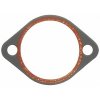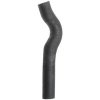jeffery
Active Member
My first attempt at a write-up here. So I'm starting easy. Apologies this is after the fact.
20 minute thermostat replacement (petrol engine)
Overview: The thermostat regulates the flow of coolant through the radiator and engine to maintain optimal operating temperature. For all the advanced features of modern vehicles, this old tech is quite unchanged. It can fail in two basic ways.
If it fails closed, van will overheat.
If it fails open, engine will not reach optimal operating temperature.
Diagnosis: My temperature gauge was reading cold at all times. I suspected the temperature sensor, but a bad thermostat could also cause this. To check this, open the engine compartment and remove the radiator cap. Start the van cold and peer into the radiator. It should be fairly still. In my case the coolant was flowing at a high speed, indicating that the thermostat was failed open.
You will need:

Duralast Gold Replacement thermostat 15868DLG ($11) or comparable (note that some other parts may fit but may be designed run your engine cooler. OEM is 180˚ F)

Fel-pro gasket 35336 ($2.50)

Dayco Hose B70939 ($14)
12mm socket
10mm socket
torque wrench
socket extensions
high tack gasket sealant (optional)
As you can see, the radiator cap has the date August 28, 2014.

Coolant was likely replaced then. It would not be a bad idea to replace it all by draining from the bottom drain plug. However, if outdoor temperature is in the teens, or you have recently changed the coolant (or will be soon) and you don't want to crawl on the cold ground, this method has a certain appeal.
In my experience with a 15+ year old Land Rover, muscling off old hoses OFTEN creates a leak that will reveal itself in coming days, so we are taking a shortcut and also avoiding that. Again, if you like your current hose, simply drain from bottom.
Place a vessel under the upper radiator hose and create a slice at the bend with a utility knife. Bend the hose as needed to drain the coolant out from the high points of the system. You will get roughly a pint.

Untighten the two hose clamps for the radiator hose. They have a Philips-style screw head. 10mm socket is more reliable. This is the thermostat end.

Slice the hose ends carefully with a knife to aid removal. I tore this hose like this with my bare hands. I am not that strong. So, we'll be doing the other hoses soon enough.

Time to pull the thermostat housing: Disconnect the cable connector to the temperature sensor (greenish brass in above photo). Remove the two brass bolts using a 12mm socket. The lower one is easier if you flip up the metal clasp for the distributor. The upper one also holds a mount for an electric connection.
Gently tap the housing with your hand or a rubber mallet to release.
As you can see, this thermostat had actually lost a weld point and is failed wide open.

To the upper left you see the housing with the old gasket. Remove ALL remains of the old gasket using gasket remover or other solvent. Scrape if you must but try to avoid using steel as it can damage the soft aluminum.
The diesel engine appears to spec RTV. The petrol uses a felt gasket. Placement is made easier by a light coating of High Tack gasket sealant to hold it in place. Simply paint metal surfaces and align the holes and stick it on there.
The new thermostat (seen at bottom) sits in a slight recess in the housing. Place jiggle valve at 12:00.
Align housing cover and reinsert the bolts, remembering to replace the electric clip mounting bracket on upper bolt.
Torque to 12-14 foot/lbs. This is quite light. If you are doing without a torque wrench DO NOT crank on them hard. I torqued to 150 inch/lbs. No leaking. Reattach temperature sensor wire.
Position your clamps on the new radiator hose and insert the ends. The new hose was very rigid in the cold. I dipped each end in a coffee mug of boiling hot water for a minute or so, which made them pliable enough to go on much easier.
Tighten hose clamps. Top off with coolant. My gauge is now giving a warm temp indication and the van is creating much more heat.
(Sorry I did not take more pics during the job. Will plan ahead next time.)
20 minute thermostat replacement (petrol engine)
Overview: The thermostat regulates the flow of coolant through the radiator and engine to maintain optimal operating temperature. For all the advanced features of modern vehicles, this old tech is quite unchanged. It can fail in two basic ways.
If it fails closed, van will overheat.
If it fails open, engine will not reach optimal operating temperature.
Diagnosis: My temperature gauge was reading cold at all times. I suspected the temperature sensor, but a bad thermostat could also cause this. To check this, open the engine compartment and remove the radiator cap. Start the van cold and peer into the radiator. It should be fairly still. In my case the coolant was flowing at a high speed, indicating that the thermostat was failed open.
You will need:

Duralast Gold Replacement thermostat 15868DLG ($11) or comparable (note that some other parts may fit but may be designed run your engine cooler. OEM is 180˚ F)

Fel-pro gasket 35336 ($2.50)

Dayco Hose B70939 ($14)
12mm socket
10mm socket
torque wrench
socket extensions
high tack gasket sealant (optional)
As you can see, the radiator cap has the date August 28, 2014.

Coolant was likely replaced then. It would not be a bad idea to replace it all by draining from the bottom drain plug. However, if outdoor temperature is in the teens, or you have recently changed the coolant (or will be soon) and you don't want to crawl on the cold ground, this method has a certain appeal.
In my experience with a 15+ year old Land Rover, muscling off old hoses OFTEN creates a leak that will reveal itself in coming days, so we are taking a shortcut and also avoiding that. Again, if you like your current hose, simply drain from bottom.
Place a vessel under the upper radiator hose and create a slice at the bend with a utility knife. Bend the hose as needed to drain the coolant out from the high points of the system. You will get roughly a pint.

Untighten the two hose clamps for the radiator hose. They have a Philips-style screw head. 10mm socket is more reliable. This is the thermostat end.

Slice the hose ends carefully with a knife to aid removal. I tore this hose like this with my bare hands. I am not that strong. So, we'll be doing the other hoses soon enough.

Time to pull the thermostat housing: Disconnect the cable connector to the temperature sensor (greenish brass in above photo). Remove the two brass bolts using a 12mm socket. The lower one is easier if you flip up the metal clasp for the distributor. The upper one also holds a mount for an electric connection.
Gently tap the housing with your hand or a rubber mallet to release.
As you can see, this thermostat had actually lost a weld point and is failed wide open.

To the upper left you see the housing with the old gasket. Remove ALL remains of the old gasket using gasket remover or other solvent. Scrape if you must but try to avoid using steel as it can damage the soft aluminum.
The diesel engine appears to spec RTV. The petrol uses a felt gasket. Placement is made easier by a light coating of High Tack gasket sealant to hold it in place. Simply paint metal surfaces and align the holes and stick it on there.
The new thermostat (seen at bottom) sits in a slight recess in the housing. Place jiggle valve at 12:00.
Align housing cover and reinsert the bolts, remembering to replace the electric clip mounting bracket on upper bolt.
Torque to 12-14 foot/lbs. This is quite light. If you are doing without a torque wrench DO NOT crank on them hard. I torqued to 150 inch/lbs. No leaking. Reattach temperature sensor wire.
Position your clamps on the new radiator hose and insert the ends. The new hose was very rigid in the cold. I dipped each end in a coffee mug of boiling hot water for a minute or so, which made them pliable enough to go on much easier.
Tighten hose clamps. Top off with coolant. My gauge is now giving a warm temp indication and the van is creating much more heat.
(Sorry I did not take more pics during the job. Will plan ahead next time.)
Last edited:
